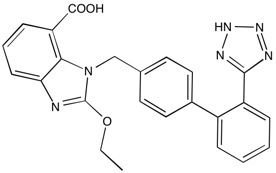Candesartan | Angiotensin II antagonist
NMR (Conforms)

Available Options
| Size: | Price | Quantity | |
|---|---|---|---|
| 50 mg | $40.00 | ||
| 250 mg | $120.00 |
Candesartan (CAS 139481-59-7) is an angiotensin II receptor I (AT1) antagonist, IC50s=1.12 and 2.86 nM for bovine adrenal cortex and rabbit aorta respectively.1 Selectively inhibits angiotensin II-induced contraction of rabbit aortic strips with no effect on contraction induced by other agents such as norepinephrine, KCl, serotonin, PGF2αor endothelin. Prevents astrocyte and microglial activation and neuroinflammation and improves hippocampal neurogenesis.2 Attenuates angiogenesis in hepatocellular carcinoma.3 Clinically useful antihypertensive agent. Ameliorates brain inflammation associated with Alzheimer’s disease.4 Active in vivo and orally active.
References/Citations:
1) Shibouta et al. (1993), Pharmacological profile of a highly potent and long-acting angiotension II receptor antagonist, 2-ethoxy-1-[[2’-(1H-tetrazol-5-yl)biphenyl-4-yl]methyl]-1H-benzimidazol-7-carboxylic acid (CV-11974), and its prodrug, (+/-)-1-(cyclohexyloxycarbonyloxy)-ethyl 2-ethoxy-1-[[2’-(1H-tetrazol-5-yl)biphenyl-4-yl]methyl]-1H-benzimidazole-7-carboxylate (TCV-116); J. Pharmacol. Exp. Therap., 266 114
2) Bhat et al. (2017), Angiotensin receptor Blockade by Inhibiting Glial Activation Promotes Hippocampal Neurogenesis Via Activation of Wnt/B-Catenin signaling in hypertension; Mol. Neurobiol., 55 5282
3) Fan et al. (2016), Candesartan attenuates angiogenesis in hepatocellular carcinoma via downregulating AT1R/VEGF pathway; Biomed. Pharmacother., 83 704
4) Torika et al. (2018), Candesartan ameliorates brain inflammation associated with Alzheimer’s disease; CNS Neurosci. Ther. 24 231
NMR (Conforms)
Safety Data Sheet:
Product Data Sheet:
Materials provided by Focus Biomolecules are for laboratory research use only and are not intended for human or veterinary applications. Please note that we do not sell to individuals and that all orders placed by non-research organizations will incur a $20 restocking/refund fee
Candesartan (CAS 139481-59-7) is an angiotensin II receptor I (AT1) antagonist, IC50s=1.12 and 2.86 nM for bovine adrenal cortex and rabbit aorta respectively.1 Selectively inhibits angiotensin II-induced contraction of rabbit aortic strips with no effect on contraction induced by other agents such as norepinephrine, KCl, serotonin, PGF2αor endothelin. Prevents astrocyte and microglial activation and neuroinflammation and improves hippocampal neurogenesis.2 Attenuates angiogenesis in hepatocellular carcinoma.3 Clinically useful antihypertensive agent. Ameliorates brain inflammation associated with Alzheimer’s disease.4 Active in vivo and orally active.
References/Citations:
1) Shibouta et al. (1993), Pharmacological profile of a highly potent and long-acting angiotension II receptor antagonist, 2-ethoxy-1-[[2’-(1H-tetrazol-5-yl)biphenyl-4-yl]methyl]-1H-benzimidazol-7-carboxylic acid (CV-11974), and its prodrug, (+/-)-1-(cyclohexyloxycarbonyloxy)-ethyl 2-ethoxy-1-[[2’-(1H-tetrazol-5-yl)biphenyl-4-yl]methyl]-1H-benzimidazole-7-carboxylate (TCV-116); J. Pharmacol. Exp. Therap., 266 114
2) Bhat et al. (2017), Angiotensin receptor Blockade by Inhibiting Glial Activation Promotes Hippocampal Neurogenesis Via Activation of Wnt/B-Catenin signaling in hypertension; Mol. Neurobiol., 55 5282
3) Fan et al. (2016), Candesartan attenuates angiogenesis in hepatocellular carcinoma via downregulating AT1R/VEGF pathway; Biomed. Pharmacother., 83 704
4) Torika et al. (2018), Candesartan ameliorates brain inflammation associated with Alzheimer’s disease; CNS Neurosci. Ther. 24 231
Calculate the molar concentration, mass or volume in a solution.
Concentration × Volume × Molecular Weight = Mass
Focus Biomolecules • Plymouth Meeting, PA USA • 1-855-FOCUS21
Focus Biomolecules
Plymouth Meeting, PA USA
1-855-FOCUS21
Website Created by Advanta Advertising LLC.

